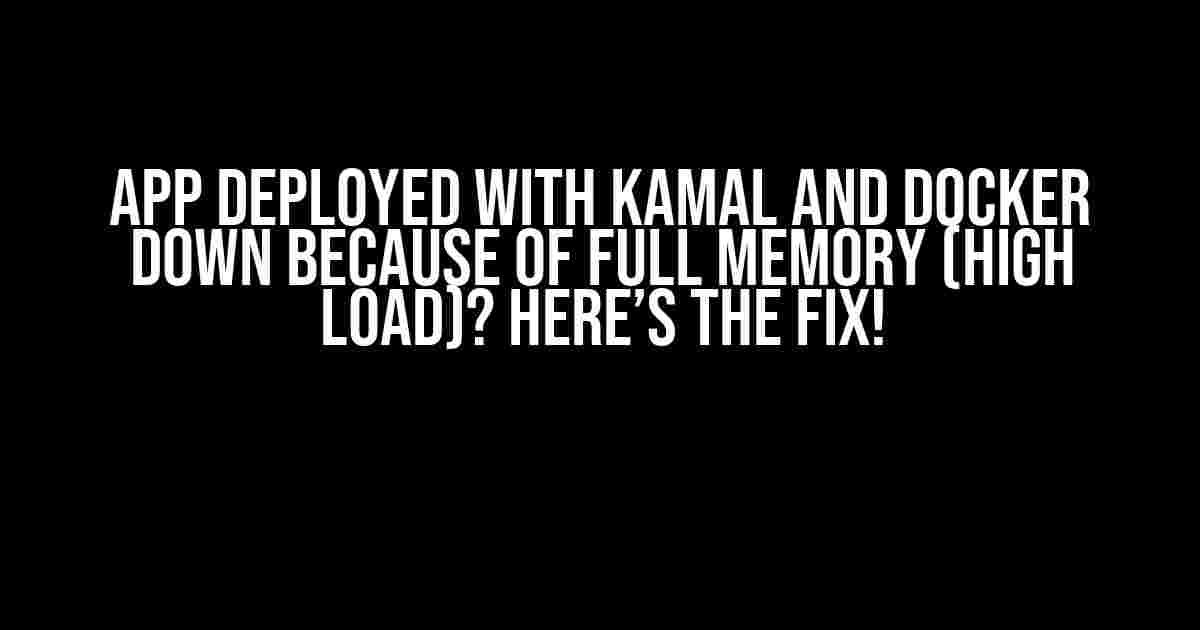If you’re reading this, chances are you’re frustrated, stuck, and eager to get your app back up and running. Don’t worry, we’ve all been there! In this article, we’ll walk you through the steps to identify and resolve the pesky issue of full memory (high load) that’s bringing your app to its knees.
What’s Going On?
So, you’ve deployed your app with Kamal and Docker, and everything seemed fine… until it wasn’t. Suddenly, your app is crawling, and your users are complaining about slow load times or, worse, crashes. You’ve checked the logs, and the culprit is clear: full memory (high load). But why?
The likely culprits are:
- Insufficient resources allocated to your Docker container
- Memory leaks in your application code
- Inefficient database queries
- Too many unnecessary dependencies
- Improperly configured caching mechanisms
Diagnosing the Issue
Before we dive into the fixes, let’s make sure we’re on the same page. To diagnose the issue, follow these steps:
- Check the Docker container’s CPU and memory usage using the command:
docker stats - Review your app’s logs for any error messages or warnings
- Use a tool like
toporhtopto monitor system resource usage - Run a memory profiling tool, such as
docker container exec -it [container_id] /usr/bin/time -v node --prof, to identify memory-intensive processes
Take note of any patterns, warnings, or errors that might indicate the root cause of the issue.
Fixing the Issue
Now that we’ve identified the problem, let’s get to fixing it!
1. Increase Docker Container Resources
Maybe your container just needs a little more breathing room. Try increasing the resources allocated to your Docker container:
docker run -d --name my-app \ -p 8080:8080 \ -m 1024m \ my-app:latest
In the above example, we’re allocating 1024MB of memory to the container. Adjust this value based on your app’s needs.
2. Identify and Fix Memory Leaks
Memory leaks can be sneaky, but we can catch them! Use a memory profiling tool to identify the leaky code:
docker container exec -it [container_id] /usr/bin/time -v node --prof
Once you’ve identified the offending code, refactor it to be more memory-efficient. For example, consider using caching mechanisms or optimizing database queries.
3. Optimize Database Queries
Sometimes, slow database queries can cause memory usage to spike. Review your database queries and optimize them using indexing, caching, or query optimization techniques.
For example, if you’re using a MySQL database, consider adding an index to a frequently accessed column:
ALTER TABLE my_table ADD INDEX my_index (column_name);
4. Remove Unnecessary Dependencies
Are there any dependencies in your app that are no longer needed? Remove them to free up resources!
For example, if you’re using Node.js and have a dependency that’s no longer used, simply remove it from your package.json file:
"dependencies": {
"unused-dependency": "^1.2.3",
// Remove this line
"another-dependency": "^4.5.6"
}
5. Configure Caching Mechanisms
Proper caching can significantly reduce memory usage. Review your caching mechanisms and configure them correctly:
For example, if you’re using Redis as a cache layer, ensure that you’re setting a TTL (time to live) for cached items:
redis.setex("my_cache_key", 3600, "cached_value");
In this example, the cached item will expire after 3600 seconds (1 hour).
Preventing Future Issues
Now that we’ve fixed the issue, let’s take some preventative measures to avoid future occurrences:
- Regularly monitor system resource usage and app performance
- Implement automated testing for memory leaks and performance issues
- Continuously review and optimize database queries
- Remove unnecessary dependencies and outdated code
- Configure caching mechanisms correctly and monitor their effectiveness
By following these steps, you’ll be well-equipped to handle full memory (high load) issues and keep your app running smoothly!
Conclusion
In conclusion, identifying and resolving full memory (high load) issues in your app deployed with Kamal and Docker requires a systematic approach. By diagnosing the issue, fixing the root cause, and taking preventative measures, you’ll ensure your app’s performance and reliability. Remember to regularly monitor and optimize your app’s resources to prevent future issues.
Happy coding, and may your app’s memory usage be forever optimized!
| Troubleshooting Steps | Description |
|---|---|
| Check Docker container stats | Use docker stats to monitor CPU and memory usage |
| Review app logs | Check for error messages or warnings in your app’s logs |
| Use memory profiling tools | Identify memory-intensive processes using tools like docker container exec -it [container_id] /usr/bin/time -v node --prof |
| Increase Docker container resources | Allocate more resources to your Docker container using the -m flag |
| Fix memory leaks | Refactor code to be more memory-efficient |
| Optimize database queries | Use indexing, caching, or query optimization techniques to improve database performance |
| Remove unnecessary dependencies | Remove unused dependencies to free up resources |
| Configure caching mechanisms | Set up correct caching mechanisms to reduce memory usage |
We hope this article has helped you resolve the issue and provided you with valuable insights to prevent future occurrences. If you have any questions or need further assistance, please don’t hesitate to ask!
Frequently Asked Questions
Get the inside scoop on troubleshooting app deployment issues with Kamal and Docker!
Why did my app deployment with Kamal and Docker go down due to full memory?
This is likely because your Docker container is consuming excessive memory, causing the system to become overloaded. Perhaps you’ve allocated insufficient memory or haven’t optimized resource usage. Check your Docker configuration, and consider implementing memory limits or optimization techniques to prevent this issue in the future.
How can I identify the root cause of the memory issue in my Kamal and Docker setup?
To diagnose the issue, inspect Docker container logs, and check system resource utilization (e.g., using `docker stats` or `htop` commands). Analyze the output to identify memory-hungry processes or containers. You can also use Docker’s built-in `docker inspect` command to inspect container configurations and resource allocations.
What are some common mistakes that can lead to full memory issues in a Kamal and Docker deployment?
Common pitfalls include not setting memory limits for containers, inadequate resource allocation, and failing to optimize images and configurations. Additionally, neglected log file maintenance, inefficient database queries, and poor caching mechanisms can also contribute to memory exhaustion.
How can I prevent full memory issues in my Kamal and Docker deployment going forward?
To avoid future memory-related issues, implement best practices like setting memory limits, optimizing images, and regularly monitoring system resources. Consider using Docker Compose to manage services, and integrate tools like Prometheus and Grafana for comprehensive monitoring and alerting.
What are some recommended tools for monitoring and troubleshooting memory issues in a Kamal and Docker environment?
Some popular tools for monitoring and troubleshooting memory issues include Docker’s built-in commands (e.g., `docker stats` and `docker inspect`), as well as third-party tools like Sysdig, cAdvisor, and New Relic. These tools provide detailed insights into container performance, resource utilization, and system health, helping you identify and resolve memory-related issues efficiently.



